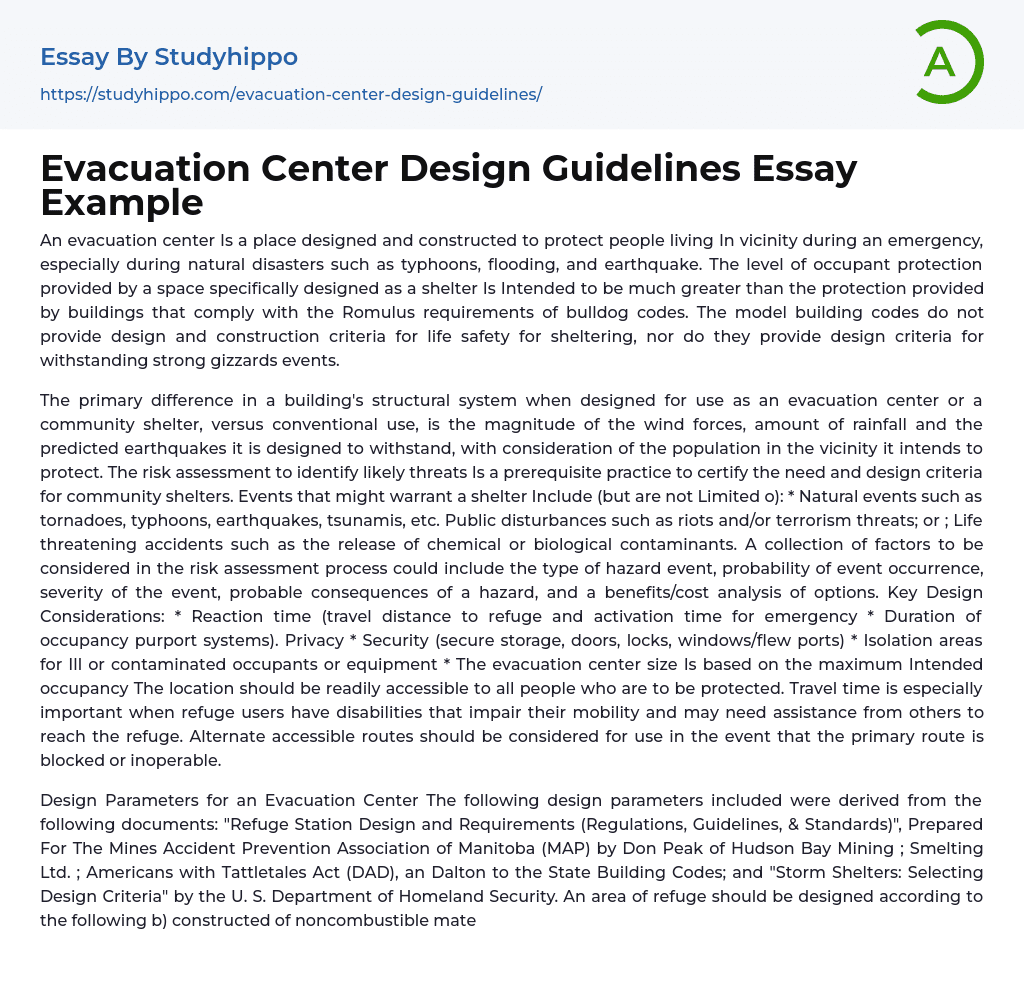An evacuation center Is a place designed and constructed to protect people living In vicinity during an emergency, especially during natural disasters such as typhoons, flooding, and earthquake. The level of occupant protection provided by a space specifically designed as a shelter Is Intended to be much greater than the protection provided by buildings that comply with the Romulus requirements of bulldog codes. The model building codes do not provide design and construction criteria for life safety for sheltering, nor do they provide design criteria for withstanding strong gizzards events.
The primary difference in a building's structural system when designed for use as an evacuation center or a community shelter, versus conventional use, is the magnitude of the wind forces, amount of rainfall and the predicted earthquakes it is designed to withstand, with consid
...eration of the population in the vicinity it intends to protect. The risk assessment to identify likely threats Is a prerequisite practice to certify the need and design criteria for community shelters. Events that might warrant a shelter Include (but are not Limited o): * Natural events such as tornadoes, typhoons, earthquakes, tsunamis, etc. Public disturbances such as riots and/or terrorism threats; or ; Life threatening accidents such as the release of chemical or biological contaminants. A collection of factors to be considered in the risk assessment process could include the type of hazard event, probability of event occurrence, severity of the event, probable consequences of a hazard, and a benefits/cost analysis of options. Key Design Considerations: * Reaction time (travel distance to refuge and activation time for emergency * Duration of occupancy purport systems). Privacy * Security (secure storage, doors
locks, windows/flew ports) * Isolation areas for Ill or contaminated occupants or equipment * The evacuation center size Is based on the maximum Intended occupancy The location should be readily accessible to all people who are to be protected. Travel time is especially important when refuge users have disabilities that impair their mobility and may need assistance from others to reach the refuge. Alternate accessible routes should be considered for use in the event that the primary route is blocked or inoperable.
Design Parameters for an Evacuation Center The following design parameters included were derived from the following documents: "Refuge Station Design and Requirements (Regulations, Guidelines, & Standards)", Prepared For The Mines Accident Prevention Association of Manitoba (MAP) by Don Peak of Hudson Bay Mining ; Smelting Ltd. ; Americans with Tattletales Act (DAD), an Dalton to the State Building Codes; and "Storm Shelters: Selecting Design Criteria" by the U. S. Department of Homeland Security. An area of refuge should be designed according to the following b) constructed of noncombustible material; (c) of sufficient size to accommodate the evacuees around the area of calamity; (d) equipped with * (I) a supply of compressed air, * a supply of potable water, * (iii) a means of communication with surface, and (e) suitably located with respect to the distance of travel from areas prone to disasters * Design wind speed and wind pressure criteria. The required design strength of the shelter is dictated by wind pressure criteria given by different guides, codes, and standards.
The design wind pressure is a function of the design wind peed. * Ramps. (a) Avoid wood construction - if used, apply abrasive
surface. (b) Preferred slope is 1:20; 1:12 is acceptable. * Interior Stairways. (a) Use contrasting markings for nosing. (b) Avoid dimly lit stairwells. (c) Do not paint white. * For the evacuation area as a whole, the following guidelines should be considered, with regards to persons with disabilities: (a) Each area of refuge shall be accessed from the space it serves by an accessible route, which serves as an accessible means of egress.
The maximum travel distance to an area of refuge shall to exceed the travel distance permitted for the occupancy by the administrative authority. Every area of refuge shall have direct access to an exit stairway or an elevator. (b) Size: Each area of refuge shall be sized to accommodate one wheelchair space for each 200 occupants or portion thereof, based on the occupant load of the area of refuge and all areas served by the area of refuge. Such wheelchair spaces shall not overlap the required means of egress width. Access to any required wheelchair space shall not be through more than one adjoining wheelchair space. C) Smoke Resistance: Every area of refuge shall be designed to prevent the intrusion of smoke.
- Building essays
- Automotive essays
- Automotive Industry essays
- Commerce essays
- Construction essays
- E Commerce essays
- Grocery stores essays
- Paper Industry essays
- Pharmaceutical industry essays
- Pharmacy essays
- Polymers essays
- Real Estate essays
- Textile Industry essays
- Android essays
- Application Software essays
- Benchmark essays
- Computer Network essays
- Computer Programming essays
- Computer Security essays
- Computer Software essays
- Cryptography essays
- Data collection essays
- Data Mining essays
- Graphic Design essays
- Information Systems essays
- Internet essays
- Network Security essays
- Website essays
- World Wide Web essays
- Architecture essays
- Design essays
- Graffiti essays
- Graphic essays
- Interior design essays
- Painting essays
- Photography essays
- Sculpture essays
- Typography essays
- Code of Ethics essays
- Conflict essays
- Dress Code essays
- Human Resources essays
- Organizational Behavior essays
- Performance essays
- Recruitment essays
- Safety essays




